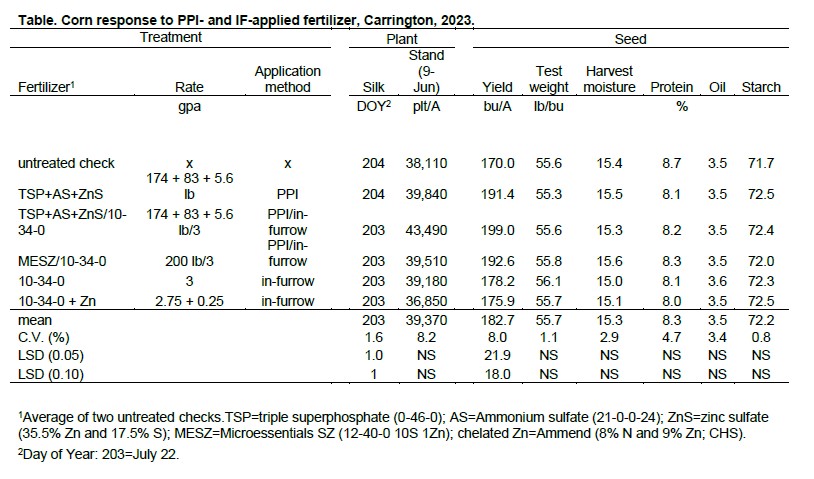A field study continued in 2023 at the NDSU Carrington Research Extension Center, and supported by the ND Corn Utilization Council, to examine the performance of corn with preplant incorporated (PPI) and in-furrow (IF) applied phosphorus (P) and zinc (Zn) fertilizer. Experimental design was a randomized complete block with four replications. The trial was established on conventionally tilled, Heimdal-Emrick loam soil with 4.0% organic matter, 7.6 (0-6 inches) and 8.0 (6-24 inches) pH, 1.88 mmho/cm (0-6 inches) and 2.41 mmho/cm (6-24 inches) soluble salts, 36 lb nitrate-N/acre, 7 ppm (low) P, 187 ppm K and 0.44 ppm (low) Zn. Wheat was the prior crop in 2022. Urea (100 lb N/acre) was PPI on May 17. PPI treatments were applied May 18 and incorporated with a field cultivator plus harrow. DeKalb ‘DKC32-86RIB’ (82-day relative maturity) Roundup Ready corn was planted with a John Deere 71 4-row flex planter on May 18 in 30-inch rows, and included IF fertilizer treatments. NDAWN monthly rain (inches): May=4.2; June=3.3; July=2.1; August=1.8; September=2.2; October=1.9; and 6-month total=15.5. Grain was combine harvested November 21.
Time from corn planting to plant emergence (trial = 8 days) was similar among treatments. Silk dates generally were one day earlier among fertilizer treatments compared to the untreated check (Table). Early season plant stand (measured June 3 at V3 growth stage) averaged 39,370 plants/acre and was similar among treatments including untreated check. Grain yield with PPI treatments increased about 13-17% (21.4-29 bu/A) compared to the untreated check. Yield response to MESZ was similar to conventional PPI fertilizer. IF treatments generally tended to increase yield compared to the untreated check. Grain harvest moisture, test weight and seed quality factors were similar among treatments.

